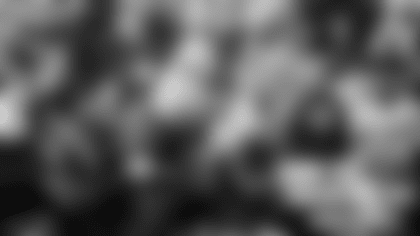Newcomers like LB Nate Webster will be schooled in the art of takeaways
On Monday, the first group of rookies will begin arriving in Tampa and by Tuesday, they'll be on the field in their practice jerseys. Next week marks the beginning of a month-long stretch in which the team is permitted to have organized, non-contact practices, a total of 14 voluntary workouts. Attendance is expected to be high.
As is the attention. With the Bucs roundly considered one of the NFC's prime Super Bowl contenders in 2000, this last warm-up for training camp will likely draw more interest in usual. And, with a new coordinator overseeing a rebuilt offensive line, a prime new receiver and a quarterback heading into his first full season as a starter, most of the attention will fall on the offensive side of the ball.
That's just fine with the Buccaneer defense, which figures it has already lost its ability to sneak up on opponents anyway. After ranking in the top three in NFL defense for each of the past three years and allowing the fewest total points over that span, the Tampa Bay D is often considered the league's best. It is without a debt one of the NFL's fastest and most aggressive units, all by design of Head Coach Tony Dungy, a former coordinator regarded as one of the league's top defensive minds.
One thing, however, has not fallen into Dungy's design, and it is an area that is sure to get the coach's attention this coming month and when camp opens in late July. While coordinator Les Steckel, linemen Jeff Christy and Randall McDaniel and wide receiver Keyshawn Johnson are finding new ways to move the ball downfield for the Bucs, the defense will be looking to take it away.
Consider the numbers in the following chart:
| 1989 | Kansas City | -8 | 8-7-1 |
| 1990 | Kansas City | +26 | 11-5 |
| 1991 | Kansas City | +11 | 10-6 |
| 1992 | Minnesota | +10 | 11-5 |
| 1993 | Minnesota | +10 | 9-7 |
| 1994 | Minnesota | 0 | 10-6 |
| 1995 | Minnesota | +11 | 8-8 |
| 1996 | Tampa Bay | -5 | 6-10 |
| 1997 | Tampa Bay | +2 | 10-6 |
| 1998 | Tampa Bay | -5 | 8-8 |
| 1999 | Tampa Bay | -4 | 11-5 |
We purposely didn't put headers on the columns to see if you could spot where the pattern went awry. Upon being told that this represents Dungy's career path over the past 11 years and his teams' turnover differentials and regular season records, two things should be immediately obvious. One, Dungy has been a consistent winner. Two, he's managed to keep those winning ways going in Tampa despite a breakdown in the turnover department.
Of course, Dungy was not the head coach in Kansas City or Minnesota, but the defensive backs coach and defensive coordinator, respectively. He would never want to receive full credit for his team's successes, even as head coach now in Tampa. Still, his secondary in K.C. was well-known for its bushels of interceptions and his defense in Minnesota not only routinely took the ball away but often scored.
Not so in Tampa, thus far, and Dungy would like to see that change. In fact, he saw it starting to turn around in the second half of 1999, when the team won eight of its last nine games and snared 25 of its 31 takeaways. In fact, the team finished near the middle of the NFL pack with a negative-4 turnover ratio, but that was an improvement over its negative-11 mark near midseason. More startling by far is this fact: through the first seven games, the Bucs scored just six points off turnovers; over the last nine games they tallied 84 points set up by fumble recoveries and interceptions. In the playoffs, they had a plus-two turnover ratio and racked up 17 points that were set up by takeaways.
"That's something we are going to try to keep going," Dungy told Buccaneers.com earlier. "That's something we've stressed ever since we've been here, and it really wasn't until midseason of '99 that we really got it going at the pace that I thought we should. We've got guys who have the ability to create turnovers, we've got a lot of speed on defense. It's something we practice and we work on, and we have from day one in '96 when we got here. But I think that the feeling among the players is that now that we've got it, we've got to keep it going, because turnovers really equal wins in the NFL."
Of course, as Dungy indicates above, the team has been stressing takeaways on defense since his arrival, so any emphasis on it in the coming weeks will be nothing new. There is a feeling, however, that the team turned the corner in that department in the second half of last year, a thought that, if true, could be scary to Buc opponents in 2000. After all, the team's stellar defensive showings in recent seasons have come almost in despite of consistently poor field position.
The Buccaneers were first in the NFC and second in the NFL in red zone defense in 1999 (determined by percentage of drives inside the 20 that resulted in touchdowns), despite 16 turnovers by the offense in its own end. Four of those were returned for touchdowns, something the defense obviously had no control over, but of the other 12, only five reached the end zone. In all, only 42.9% of Tampa Bay turnovers in 1999 resulted in scores for its opponents, while 58.1% of the Bucs' takeaways were converted into points. While no NFL coach argues Dungy's contention that turnovers equal wins, it is instructive to note that some teams do more with their takeaways than others. It would appear that Tampa Bay is poised to take full advantage of it if the team indeed continues to improve on its turnover differential.
No such glory will come of any interceptions produced in the informal practices of the next four weeks, no points will go on the board. In fact, since the defense will be squared up against its own offensive teammates, any turnover has both positive and negative connotations.
But that doesn't mean they won't be trying.
























